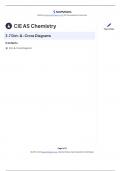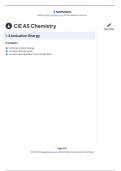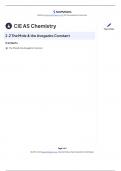Haydenash
On this page, you find all documents, package deals, and flashcards offered by seller haydenash.
- 18
- 0
- 2
Community
- Followers
- Following
20 items

Unit 3
CIE AS Chemistry covers dot-and-cross diagrams for bonding, ionic bonding through electron transfer, and covalent bonding via electron sharing. It discusses electronegativity trends and intermolecular forces, including hydrogen bonding and van der Waals forces, impacting physical properties like boiling points.
- Package deal
- • 7 items •
- Dot-&-Cross (Lewis Dot Structure) Diagrams • Summary
- Intermolecular Forces, Electronegativity & Bond Properties • Summary
- Shapes of Molecules • Summary
- Covalent Bonding & Coordinate (Dative Covalent) Bonding • Summary
- Metallic Bonding • Summary
- And more ….
CIE AS Chemistry covers dot-and-cross diagrams for bonding, ionic bonding through electron transfer, and covalent bonding via electron sharing. It discusses electronegativity trends and intermolecular forces, including hydrogen bonding and van der Waals forces, impacting physical properties like boiling points.

Unit 2
The document covers CIE AS Chemistry topics, including reacting masses, mole calculations, and percentage yield. It discusses ionic compounds, balancing equations, empirical formulas, and water of crystallization. Additionally, it explains the mole concept, Avogadro's constant, and relative atomic/molecular masses, offering a solid foundation.
- Package deal
- • 4 items •
- Reacting Masses & Volumes (of Solutions & Gases) • Summary
- Formulas • Summary
- The Mole & the Avogadro Constant • Summary
- Relative Masses of Atoms & Molecules • Summary
The document covers CIE AS Chemistry topics, including reacting masses, mole calculations, and percentage yield. It discusses ionic compounds, balancing equations, empirical formulas, and water of crystallization. Additionally, it explains the mole concept, Avogadro's constant, and relative atomic/molecular masses, offering a solid foundation.

Electrons, Energy Levels & Atomic Orbitals
The text provides a comprehensive overview of the electronic structure of atoms, focusing on electrons, energy levels, and atomic orbitals. It explains how electrons are arranged around the nucleus in principal energy levels or quantum shells, defined by principal quantum numbers (n). Each shell can contain a specific number of electrons, and shells are divided into sub-shells (s, p, d, f), which further contain orbitals. The document highlights the rules for filling these orbitals based on ener...
- Summary
- • 20 pages •
The text provides a comprehensive overview of the electronic structure of atoms, focusing on electrons, energy levels, and atomic orbitals. It explains how electrons are arranged around the nucleus in principal energy levels or quantum shells, defined by principal quantum numbers (n). Each shell can contain a specific number of electrons, and shells are divided into sub-shells (s, p, d, f), which further contain orbitals. The document highlights the rules for filling these orbitals based on ener...

Ionization Energy
The text provides a detailed overview of ionisation energy, defining it as the energy required to remove an electron from an atom or molecule. It explains the concept of first and second ionisation energies, highlighting that ionisation processes are endothermic and measured under standard conditions. The text discusses trends in ionisation energy across periods and down groups in the periodic table, noting that ionisation energy increases across a period and decreases down a group due to factor...
- Summary
- • 10 pages •
The text provides a detailed overview of ionisation energy, defining it as the energy required to remove an electron from an atom or molecule. It explains the concept of first and second ionisation energies, highlighting that ionisation processes are endothermic and measured under standard conditions. The text discusses trends in ionisation energy across periods and down groups in the periodic table, noting that ionisation energy increases across a period and decreases down a group due to factor...

Relative Masses of Atoms & Molecules
The text provides an overview of the concept of relative masses of atoms and molecules in chemistry. It defines the atomic mass unit (u), which is based on the mass of a carbon-12 isotope, and explains relative atomic mass (A), which is a ratio of the average mass of an element’s atoms to the unified atomic mass unit. The document describes how isotopes are represented and how to calculate the average atomic mass using percentage abundances. Additionally, it introduces relative molecular mass ...
- Package deal
- Summary
- • 3 pages •
The text provides an overview of the concept of relative masses of atoms and molecules in chemistry. It defines the atomic mass unit (u), which is based on the mass of a carbon-12 isotope, and explains relative atomic mass (A), which is a ratio of the average mass of an element’s atoms to the unified atomic mass unit. The document describes how isotopes are represented and how to calculate the average atomic mass using percentage abundances. Additionally, it introduces relative molecular mass ...

The Mole & the Avogadro Constant
The text provides a detailed overview of the Avogadro constant and its significance in chemistry, particularly in relation to the concept of the mole. The Avogadro constant, valued at approximately (6.02 times 10^{23}), represents the number of particles (atoms, molecules, ions, or electrons) in one mole of a substance. It explains that one mole of any element corresponds to its relative atomic mass in grams. The text also provides worked examples to illustrate how to calculate the mass and ...
- Package deal
- Summary
- • 3 pages •
The text provides a detailed overview of the Avogadro constant and its significance in chemistry, particularly in relation to the concept of the mole. The Avogadro constant, valued at approximately (6.02 times 10^{23}), represents the number of particles (atoms, molecules, ions, or electrons) in one mole of a substance. It explains that one mole of any element corresponds to its relative atomic mass in grams. The text also provides worked examples to illustrate how to calculate the mass and ...

Formulas
The text outlines essential concepts in CIE AS Chemistry, focusing on ionic compounds, balancing equations, empirical and molecular formulas, and water of crystallization. It explains how ionic compounds consist of metal and non-metal ions that balance charges to maintain electrical neutrality. The use of Roman numerals to indicate the charge of transition metals is highlighted. The text also covers the importance of balancing chemical equations to ensure the conservation of mass, detailing the ...
- Package deal
- Summary
- • 13 pages •
The text outlines essential concepts in CIE AS Chemistry, focusing on ionic compounds, balancing equations, empirical and molecular formulas, and water of crystallization. It explains how ionic compounds consist of metal and non-metal ions that balance charges to maintain electrical neutrality. The use of Roman numerals to indicate the charge of transition metals is highlighted. The text also covers the importance of balancing chemical equations to ensure the conservation of mass, detailing the ...

Reacting Masses & Volumes (of Solutions & Gases)
The text provides a comprehensive overview of key concepts related to reacting masses and volumes in CIE AS Chemistry. It explains how to calculate the number of moles using the formula (mass/molar mass), the importance of balanced chemical equations for determining the reacting masses, and the concept of percentage yield. Additionally, it covers the distinction between limiting and excess reagents, the principles of gas volume calculations (based on Avogadro’s hypothesis), and the relationshi...
- Package deal
- Summary
- • 8 pages •
The text provides a comprehensive overview of key concepts related to reacting masses and volumes in CIE AS Chemistry. It explains how to calculate the number of moles using the formula (mass/molar mass), the importance of balanced chemical equations for determining the reacting masses, and the concept of percentage yield. Additionally, it covers the distinction between limiting and excess reagents, the principles of gas volume calculations (based on Avogadro’s hypothesis), and the relationshi...

Electronegativity & Bonding
The text discusses the concept of electronegativity, defined as the ability of an atom to attract electrons in a covalent bond. It highlights trends in electronegativity across the periodic table, noting that it increases across a period and decreases down a group. The Pauling scale is introduced as a method for quantifying electronegativity values, with fluorine being the most electronegative element. Factors influencing electronegativity include nuclear charge, atomic radius, and shielding eff...
- Package deal
- Summary
- • 12 pages •
The text discusses the concept of electronegativity, defined as the ability of an atom to attract electrons in a covalent bond. It highlights trends in electronegativity across the periodic table, noting that it increases across a period and decreases down a group. The Pauling scale is introduced as a method for quantifying electronegativity values, with fluorine being the most electronegative element. Factors influencing electronegativity include nuclear charge, atomic radius, and shielding eff...

Ionic Bonding
Ionic bonding is the process where metals transfer electrons to non-metals, resulting in the formation of positively charged cations and negatively charged anions. This transfer leaves both elements with full outer electron shells, resembling the electronic configuration of noble gases. The electrostatic attraction between these oppositely charged ions gives rise to ionic bonds, creating a strong bond that forms ionic compounds, typically arranged in a crystalline lattice structure. Examples inc...
- Package deal
- Summary
- • 10 pages •
Ionic bonding is the process where metals transfer electrons to non-metals, resulting in the formation of positively charged cations and negatively charged anions. This transfer leaves both elements with full outer electron shells, resembling the electronic configuration of noble gases. The electrostatic attraction between these oppositely charged ions gives rise to ionic bonds, creating a strong bond that forms ionic compounds, typically arranged in a crystalline lattice structure. Examples inc...
